Le tombe 402 e 403 di Lavello (PZ) in contrada Casino : un'analisi dei contesti a quarant'anni dalla scoperta
P. 1-36
The collective tombs 402 and 403 of Lavello are two rock-cut hypogea, both dating back to the Copper Age and located in south-eastern Italy, in the Ofanto river valley. They were identified in 1981 within a Daunian necropolis of the 7th century BC. Preliminary information has been given, but until today there has been no complete publication. The continuity of use of the funerary space resulted in both the handling of the bones and the moving of grave goods. Despite the secondary deposition of the deceased and some post-deposition disturbances, the accompanying vessels were almost intact. In tomb 402, the last deposited burial was still in situ, with two vessels near the head.
Tomb 403, on the other hand, was not as well preserved, and some burials appeared to have been destroyed in ancient times: in the first level brought to light by the excavation, only secondary burials were present. In the grave goods of tomb 402 there were two metal objects, a Laterza-type blade and a Gaudo-type dagger, both probably made of copper, although specific analyses are lacking. In the two tombs, 40 vases in good condition were also found, as well as 18 fragmentary but recognisably vases.
Despite the influence of a strict funerary ritual, involving the use of few locallyproduced vases, the ceramic decoration suggests frequent contacts with othercommunities and shows clear similarities with Cetina, Ortucchio and especially Campaniforme. The tombs were in use for a fairly long period; based onabsolute dates from similar contexts, the earliest phase corresponds at leastin part to an advanced phase of the Late Copper Age in south-eastern Italy, inthe first half of the 3rd millennium, between 2900/2750 and 2600-2500 BC,while the most recent phases correspond to the advanced and final phases of theLate Copper Age, in the second half of the 3rd millennium, and perhaps to thebeginning of the Early Bronze Age, around 2300/2150 BC. [Publisher's text]
-
store_in_same_fr
-
information
doiCode: 10.32097/1263
issn: 2282-457X
KEYWORDS
- Eneolitico, Tombe collettive, Italia sud-orientale
- Copper Age, Collective tombs, South-Eastern Italy


